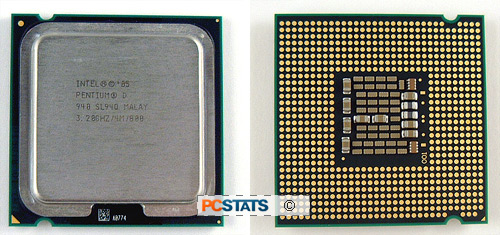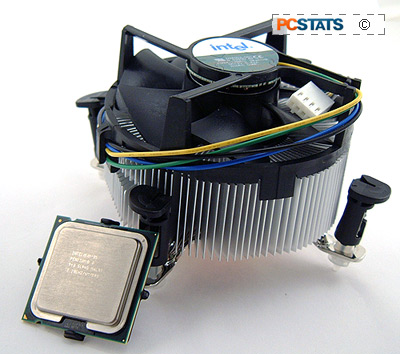It might have taken two years to do it, but
Intel has firmly laid the Prescott fiasco behind itself. For those who are
not familiar, Intel experienced huge manufacturing problems moving its Pentium 4
Netburst architecture from 130nm to the 90nm manufacturing
process the 'Prescott' core was built on. An abnormally high voltage leak caused
the Prescott core to draw a significant amount of power, and consequently
it generated a lot of heat. The prompted Intel to look for a different architecture, and resulted in the cancellation of the 'Tejas' core which reportedly output more than 150W.
Fast forward to 2006 and the seas are much calmer for Intel and its 65 nanometer manufacturing process. It's 65nm fab is up and running smoothly by all accounts and 40nm is even on the horizon. Multiprocessing remains entrenched, and four, eight or even 32 course on a single CPU seem to be projected for the future.
These changes to the way computer processors are
used makes a lot of sense if we acknowledge that performance increases
via stepped up megahertz clock speeds is no longer a viable option. In the
absence of 4GHz to 4.2GHz speed increases, the industry has sought to
mitigate CPU improvements by doubling up on processor cores, on one slab of
silicon. Multiprocessing in and of itself is not a new idea, high end
workstations and servers have long benefited from SMP (Symmetrical Multi
Processing) going back to the days of the Cray computer. In recent times Intel
first introduced Pentium 4 processors with a technology called Hyperthreading that created two logical cores from one. Then came the first generation of true dual physical core Intel Pentium D processors; a band aid fix by most accounts but none the less a good improvement to the P4. Intel's latest generation of Pentium D processors are built on the 65 nanometer manufacturing process and include an increased amount L2 Cache which makes them even more competitive.
The Intel Pentium D 940 processor is the latest victim,
errr.... component to pass through the PCSTATS test labs. Built on Intel's 65
nanometer manufacturing process and with two physical processing cores
running at 3.2 GHz each, backed up by 2MB of L2 cache, the socket
775 chip certainly makes quite a splash. The Pentium D 840 is more
than ever a worthy competitor to AMD's dual
core Athlon64 processors. The Pentium D 940 processor runs on an 800
MHz Front Side Bus (FSB) and uses Intel's pinless Socket 775 form factor. The
retail processor is sold with a Pulse Width Modulation fan based heatsink that
runs quietly and very effectively. If you're an overclocker, there are plenty of
after market thermal solutions to consider, like the ECT Prometeia Mach II GT phase change cooler that PCSTATS tested previously that will make reaching stratospheric clock speeds much simpler... brrrr!
 |
|
3.2GHz Intel Pentium D 940 Processor |
|
|
 |
| Tech
Specs |
|
Pentium D
940
Clock: 3.2 GHz (Dual Core)
L1: 16KB
(Per Core)
L2: 2048KB (Per Core)
Multipiler:
16x
Package: 775 Pinless
Socket: 775
organic
mPGA
Core: 65nm
Vcore: 1.25-1.4V
Cost: $217
USD |
|
| |
Pentium D processors are split into two groups, the 800-series which
are built on the 90nm process and incorporate 230 million transistors, and the
more advanced 900-series which are built on 65nm and have a total of 376
million transistors. The Intel Pentium D 940 CPU has a maximum power requirement
of 95 Watts, 45W less than the Pentium D 840 model PCSTATS tested previously. Each
core on the Pentium D 940 has access to its own L1 and L2 cache
memory, 16KB and 2MB respectively. Both class of processor run on
a 800MHz front side bus like traditional Prescott Pentium 4s, and are
currently only supported with DDR II memory.
 The Pentium D 940
represents the state of the art in Intel processors, not just because of its
dual core nature, but because of the other features it incorporates as well.
The Pentium D 940
represents the state of the art in Intel processors, not just because of its
dual core nature, but because of the other features it incorporates as well.
The most significant extra that this CPU brings to the table is its support
for 64-bit x86-64-based operating systems through Intel's EMT64 technology.
Like AMD's Opteron and Athlon 64, the Intel Pentium
D processor can run both 32-bit and 64-bit operating systems and applications
(almost) interchangeably. For more details on how this works, see PCSTATS article on the subject.
The second new(ish) feature is support
for the NX Bit, a form of system security which attempts to end the possibility
of buffer overflow attacks - where malicious software overloads an area of
memory then uses the resulting memory hole to execute alien programs - by
restricting which areas of memory can execute application code. The NX Bit
feature must be supported by both the operating system and the processor.
The Intel Pentium D 800 and 900 series
processors also incorporate Intel's EIST (Enhanced Intel SpeedStep Technology),
as seen in the 6xx line of Pentium 4 processors. EIST can sense when
the cores are being under utilized and dynamically reduce the CPU multiplier
to slow down the processor, reducing both energy consumption and heat
output.
EIST works hand in hand with Intel's
TM2 (Thermal Monitor 2) and C1E advanced halt state technologies which monitor
and reduce the processor's speed in overheating and idle conditions
respectively. A speed of 2.8GHz (14 x 200) is the lowest state to which EIST
will reduce the Pentium D's speed though, which explains why the Intel Pentium D
820 processor ( which runs at 2.8GHz already) does not feature this technology,
nor TM2 and C1E support.
Last but not least is support for a
technology called hardware virtualization. Intel's Virtualization Technology
(VT) is one of the new technologies supported in the Pentium D 940, although
there are few software applications at this time actually available to make use
of it. Virtualization Technology enables a processor to act as if it were
several processors working in parallel, in order to create an environment where
several operating systems can be run at the same time on the same computer.
As exciting as this all sounds, the
tools necessary to take advantage of this are absent from the desktop
marketplace, although software virtualization packages like VMware have been
around for years. Moving the capabilities of virtualization from software into
hardware is seen as a way to add flexibility into processors. Hardware
Virtualization has its roots in Microsoft's Palladium initiative, and both Intel
and AMD have pressed ahead and implemented the feature support into the latest
generation of processors.
Now, on to dual core single-cores...

